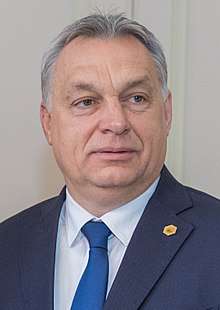Prime Minister of Hungary
The Prime Minister of Hungary (Hungarian: miniszterelnök) is the head of government in Hungary. The Prime Minister and the Cabinet are collectively accountable for their policies and actions to the Parliament, to their political party and ultimately to the electorate. The current holder of the office is Viktor Orbán, leader of the Fidesz – Hungarian Civic Alliance, who has served since 29 May 2010.[3]
| Prime Minister of Hungary
Magyarország miniszterelnöke | |
|---|---|
.svg.png) Coat of arms used by the Prime Minister[1] | |
| |
| Style | Mr. Prime Minister (informal) His Excellency (diplomatic) |
| Member of |
|
| Reports to | National Assembly |
| Seat | Karmelita Monastery (Budapest, Színház Street 5-7) |
| Nominator | President of Hungary |
| Appointer | Elected by National Assembly |
| Term length | Four years, no term limit |
| Inaugural holder | Count Lajos Batthyány |
| Formation | 17 March 1848 |
| Deputy | Deputy Prime Minister |
| Salary | HUF 25,680,000 annual, including MP's salary[2] |
| Website | The Prime Minister's Office |
 | ||||
|---|---|---|---|---|
| This article is part of a series on the politics and government of Hungary | ||||
|
| ||||
|
Constitution
|
||||
|
Executive
|
||||
|
Parliament
|
||||
|
Recent elections
|
||||
|
||||
|
Administrative divisions
|
||||
|
Foreign relations
|
||||
| ||||
According to the Hungarian Constitution, the Prime Minister is nominated by the President of Hungary and formally elected by the National Assembly. Constitutionally, the President is required to nominate the leader of the political party who wins a majority of seats in the National Assembly as Prime Minister.[4] If there is no party with a majority, the President holds an audience with the leaders of all parties represented in the Assembly and nominates the person who is most likely to command a majority in the Assembly, who is then formally elected by a simple majority of the Assembly. In practice, when this situation occurs, the Prime Minister is the leader of the party winning a plurality of votes in the election, or the leader of the senior partner in the governing coalition. The Prime Minister has a leading role in the executive branch in accordance with the Hungarian Constitution, which vests him with the power to "define the general policy of the Government." The Prime Minister selects Cabinet ministers and has the exclusive right to dismiss them. Cabinet nominees appear before one or more parliamentary committees in consultative open hearings. They must then survive a vote by Parliament and be formally approved by the President.
Official title
The title of Hungary's head of government in Hungarian is miniszterelnök. Literally translated, this means "Minister-President". However, since "Prime minister" or "premier" is the more usual title in a parliamentary system for a head of government in English-speaking nations, the title is translated as "Prime Minister" by most English sources.
History of the office

Palatine of Hungary
The palatine (Latin: comes palatii, comes palatinus, later palatinus (regni), Hungarian: nádorispán/ nádor, Slovak: nádvorný župan/ nádvorný špán, later: palatín / nádvorník, German: Palatin) was the highest dignitary in the Kingdom of Hungary after the king (a kind of powerful Prime Minister and supreme judge) from the kingdom's rise up to 1848/1918.
Initially, he was in fact the representative of the king, later the vice-regent (viceroy). In the early centuries of the kingdom, he was appointed by the king, later elected by the Diet of the Kingdom of Hungary. After the Habsburgs solidified their hold of Hungary, the dignity became an appointed position once again. Finally, it became hereditary in a cadet (junior) branch of the Habsburg dynasty after King Francis appointed his brother Joseph.
Creation of the position
During the Hungarian Revolution of 1848 the revolutionaries wanted the creation of a Hungarian cabinet which would be independent from the Austrian Empire and the Buda Chancellery (which was office of the Imperial Governor-General). One of the 12 points said: 2. A responsible government in Buda-Pest.
Ferdinand V appointed Count Lajos Batthyány for the position of Prime Minister of Hungary on 17 March 1848. The government was called ministry, differently from the current acceptation. The ministries were called departments. Batthyány resigned on October 2, 1848 he was succeeded by Lajos Kossuth as President of the Committee of National Defence. This executive body has not been allocated the portfolios. In April 1849, when the Hungarians had won many successes, after sounding the army, Kossuth issued the celebrated Hungarian Declaration of Independence. In May Bertalan Szemere was appointed Prime Minister. The position was vacant after the defeat of the freedom fight.
List of officeholders
Living former Prime Ministers
As of April 2020, 5 former Prime Ministers of Hungary are alive. Viktor Orbán, who served as Prime Minister from 1998 to 2002, is currently serving and thus is not included on this list.
| Name | Term of office | Date of birth |
|---|---|---|
| Miklós Németh | 1988–1990 | 24 January 1948 |
| Péter Boross | 1993–1994 | 27 August 1928 |
| Péter Medgyessy | 2002–2004 | 19 October 1942 |
| Ferenc Gyurcsány | 2004–2009 | 4 June 1961 |
| Gordon Bajnai | 2009–2010 | 5 March 1968 |
See also
- Records of Prime Ministers of Hungary
- List of Prime Ministers of Hungary by tenure
- List of Prime Ministers of Hungary (graphical)
- List of heads of state of Hungary
- List of rulers of Hungary
- List of palatines of Hungary
References
- "2011. évi CCII. törvény Magyarország címerének és zászlajának használatáról, valamint állami kitüntetéseiről" [Act CCII of 2011 on the Use of the Coat of Arms and Flag of Hungary and on State Awards]. CompLex Hatályos Jogszabályok Gyűjteménye (in Hungarian). Retrieved 21 February 2017.
- "How much cost is the PM's work? And others? 2,14 million HUF per month, annually 25,68 million.(Hungarian)". Retrieved 10 March 2018.
- "Members of the Government". Retrieved 10 March 2018.
- "The Fundamental Law of Hungary (English)" (PDF). Hungarian State. Retrieved 8 May 2017.
External links
| Wikimedia Commons has media related to Prime ministers of Hungary. |
